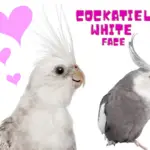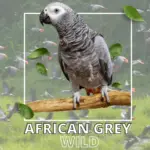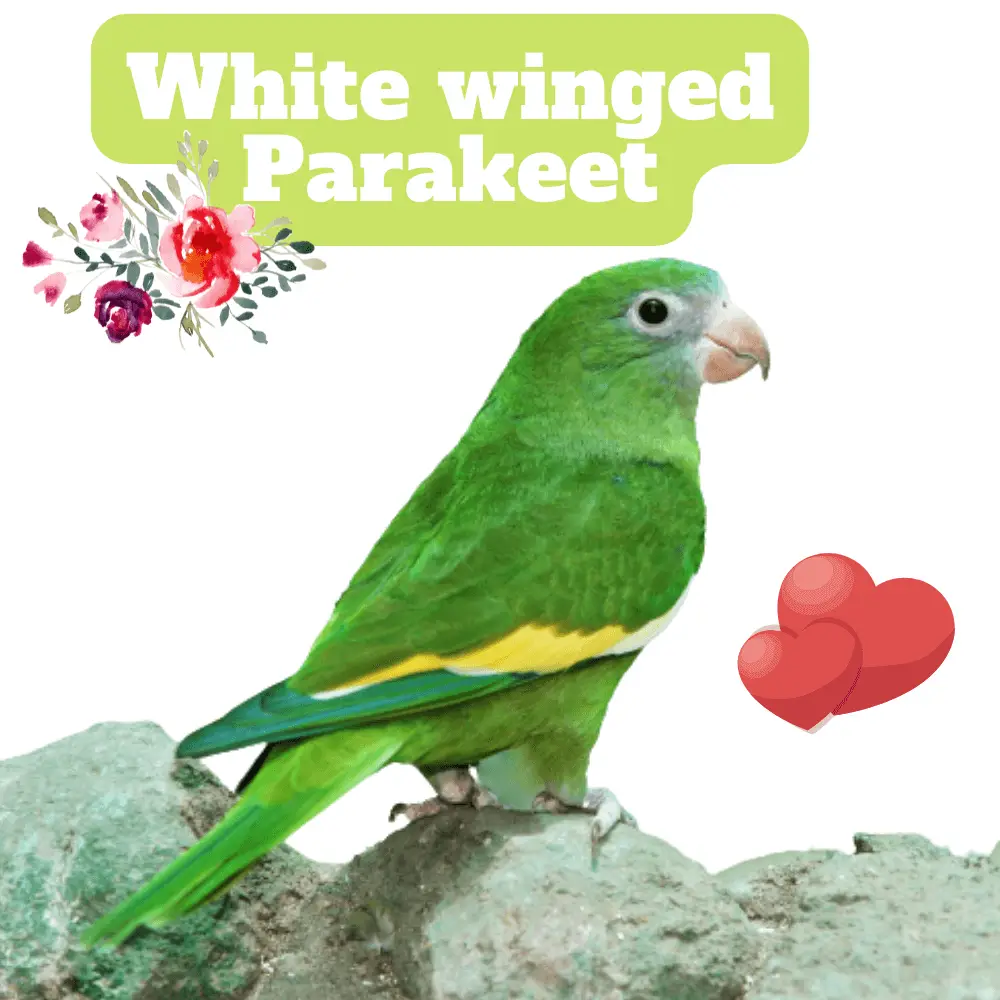
White winged Parakeet Small (22–25 cm total length), predominantly green parakeet with a moderately long, sharply pointed tail, and yellow and white wings.
Noisy in flight, calling incessantly, but maybe inconspicuous and quiet when perched and foraging. Flight is swift and direct, sometimes weaving.
Sexes are similar, and plumages are similar throughout the year. The greater wing covers yellow; inner primaries and secondaries are white, forming a large, triangular white-and-yellow patch on the wing that is visible in flight even at a great distance.
White flight feathers appear translucent in flight, especially when seen from below. At rest, the white secondaries and inner primaries are hidden, and the yellow wing coverts are most conspicuous. Lores are only sparsely feathered. Bill pale horn (DB).
Immatures are similar, but white primaries are fewer in number and usually broadly tipped with greenish-black; greater coverts yellow,
edged with green; this green edging may make yellow of wing hard to see on perched immatures. It may take ≥ 2 yr before birds attain characteristic clean white and yellow on wings.
Similar Species
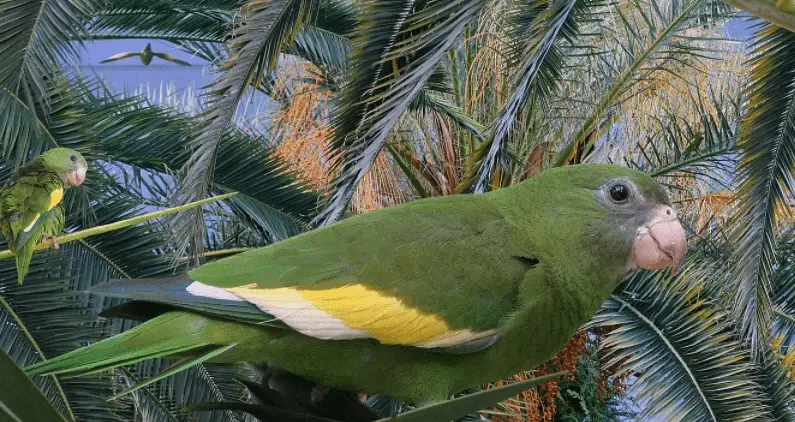
A combination of the solid green body, long pointed tail, and yellow greater wing coverts distinguishes White-winged and Yellow-chevroned parakeets from all other parrots that have been recorded in the U.S.
Because white wings of perched White winged parakeet are not usually visible, perched Yellow-chevroned Parakeets are best distinguished by the darker bill.
Flying Yellow-chevroned Parakeets show yellow only on the upper surface of the wing and this may not be obvious on distant flying birds.
In comparison, large triangles of white on the wings of White-winged are always clearly visible in flight. Distant White-wings may appear as dark specks flashing white as they raise and lower wings,
an effect never seen with Yellow-chevroned Parakeets. Immatures are similar to adults, but greater coverts are yellow, edged with green, as in immature White-winged Parakeets.
Habitat
White winged Parakeet in Miami-Dade
SOURCE: Rangel Diaz
Feeding
Almost exclusively arboreal while foraging, generally staying high in trees. Readily descends within 2 m of ground to forage in low trees, or occasionally drops to the ground to forage under bird feeders (DB).
Food Capture And Consumption
From Schroads 1974 and DB. Flocks revisit specific trees until they have stripped the tree of fruit, often starting at the top and working their way down and toward the center of the tree.
In Brazil, single birds or flocks of up to 11 individuals visited individual trees. Often acrobatic while foraging—e.g., hanging upside down on narrow stems and branches to reach fruits and flowers.
Flowers: Eats flowers in a variety of ways:
(1) Sips nectar while leaving flower undamaged and attached to the tree;
(2) picks flowers and holds them on their foot while sipping nectar or eating pistil, stamen, and corolla;
(3) chews blossom and works it through a bill, presumably to extract nectar.
Fruits: Either pick small fruits and eat them directly or hold them in one foot and eat them. Using a bill, may pull an entire raceme of fruit up to perch, hold it in one foot, and select individual fruits.
Often accomplishes this task without removing raceme from a tree. Returns daily to eat open and partly eaten mangoes and other large fruits.
Seeds: Uses beak to tear away pieces of fruit wall and consume seeds, often perching upside-down to do so. Occasionally eats Eriotheca plant as well.
Brotogeris parakeets are usually “left-footed,” holding food in their left foot and perching on their right foot while eating. Photos from Miami show one individual holding fruit on the left foot and another holding fruit on the right foot.
Diet
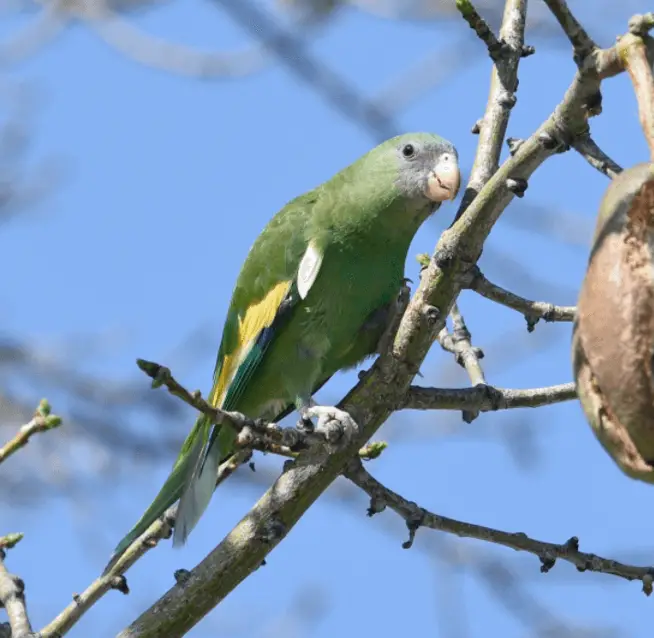
Few data from the native range, but studies in Florida and California provide a good indication of what this species consumes in the U.S.
Major Food Items
Florida: Based on Bundy 1970 and Schroads 1974. Figs, including exotic species: lofty fig (Ficus altissimo), weeping fig (F. Benjamina), and Bodhi tree (F. religiosa) and natives Florida strangler fig (F. aurea) and wild banyan tree (F. citrifolia).
Inflorescences and fruits of palm trees including exotic Washingtonia palm (Washingtonia robusta) and Canary Island date palm; and native royal palm, Florida thatch palm, and cabbage palms.
In addition, consumes seeds, fruits, buds, stem tips, and blossoms from a variety of other species, including Australian pine, cecropia, Queensland umbrella tree, African tulip tree, floss-silk tree, ear leaf acacia, Barbados cherry, Chinaberry,
Ceylon gooseberry, orangeberry, strawberry tree, mahoe, cajeput, and bottlebrush tree.
Exotic species of commercial importance that this species consumes include mango, avocado, tomato, and banana.
Among native species, eats acorns of live oak, pods of the native black olive tree, and sea grapes.
California: Based on Hardy 1973 and Arrowood 1981. A mixture of native and exotic species, including white wood seeds, Port Jackson fig fruit, coral tree nectar, avocados, citrus fruits, peaches, plums, apricots, apples, poplar buds, Monterey cypress buds, atlas cedar buds, eucalyptus nectar, acacia flowers, southern magnolia flowers, Canary Island date palm fruits, and edible fig.
At bird feeders: Large quantities of sunflower seeds. In a single feeder in Miami, a flock of 300–350 consumed nearly 180 kg of birdseed a month. In California, the diet during the winter months is often composed almost exclusively of sunflower seeds taken from feeders.
The use of individual bird feeders may be seasonally sporadic, indicating some local movement, change in diet, or change in food availability.
South America: No evidence that the birds eat the termites whose nests they burrow into for nesting. In Brazil, the seeds of the fruit. Individuals in an introduced population in Ecuador were recorded eating mangoes, flowers of palms, fruits of Ficus spp., and Samanea saman trees.
Food Selection and Storage
Individuals appear to visually inspect fruits before choosing among them. In addition, often pick fruits and flowers and drop them uneaten, suggesting that individuals are selective about what they consume, though selection criteria have not been analyzed critically.
Not known to store food. In Brazil, only consumed immature fruit of Pseudobombax Grandiflora and whole seeds were never dropped.
Sounds and Vocal Behavior
White-winged Parakeets produce several loud, raucous calls in a variety of social contexts. All of the following call types are given at a variety of intensities.
Although detailed work on vocal repertoire is lacking for this species, the intensity of call likely depends on the intensity of the social situation in which it is delivered (Power 1966a). The White winged parakeet likely has more call types than described here, and more study is needed.
Plumages
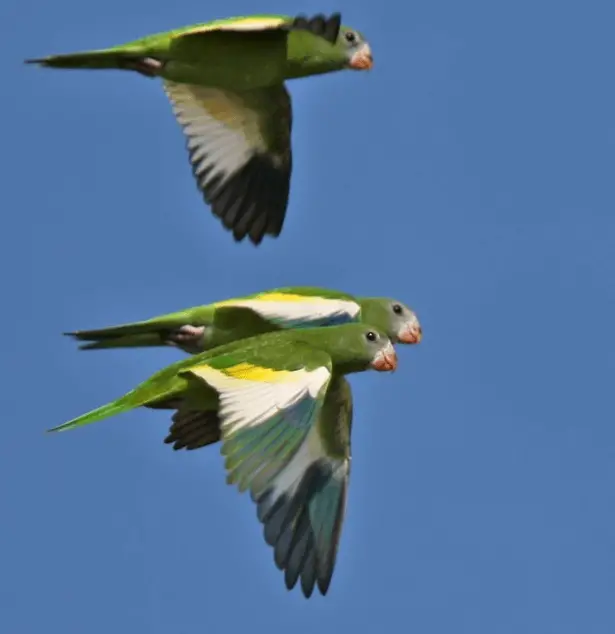
White-winged Parakeets have 10 full-length primaries (numbered distally, p1–p10), 10 secondaries (numbered proximally, s1–s7 and including 3 tertials, numbered distally t1–t3), and 12 rectrices (numbered distally on each side of the tail, r1–r6);
psittacids are diastatic indicating that a secondary has been lost evolutionarily between what we now term s4 and s5. Little or no geographic or sex-specific variation in appearance was described.
Geographic variation in the timing of molt likely occurs between native South American and non-native Florida populations due to opposite seasonal regimes;
the timing of molts and plumages described here is based on presumed strategies within Florida populations. The timing of molts in native populations is unknown although extents and sequences are likely similar.
Following based primarily on plumage descriptions of Forshaw and Schroads; photos in Harris and Arndt (1992-1996); note that the plate illustrating White-winged Parakeet in Juniper and Parr (1998) shows some characters of Yellow-chevroned Parakeet instead.
Sexes similar in all plumages; Definitive Plumage attained at Second or possibly Third Basic Plumage (see below). Colors in the following descriptions follow Smithe (1975–1981).
Natal Down
Present primarily Mar-Jun in Florida, in the nest. Hatchlings naked, with sparse down. Young 18–19 d old have large down feathers arising from posterior dorsal and femoral feather tracts and thinly scattered smaller plumes arising from anterior and posterior dorsal, femoral, and ventral tracts.
Juvenile (First Basic) Plumage
Present primarily May-Sep in Florida, in the nest. Similar to Definitive Basic Plumage except upperpart feathers fringed brown, some with additional narrow subterminal horizontal brown bands; rectrices spotted and marked distally with brown;
outer 5–6 upper wing greater coverts duller yellow, usually with dark rachis and margined distally with green; remaining greater coverts predominantly green with white on the inner web; outer web of longest tertial (t3) green with a yellow tip; white secondaries with dark shafts,
the outer two (s1 and s2) margined distally and the remainder margined along with the outer web with greenish-black and the inner web of s2–s7 dark brown; white inner primaries (p1–p4) and corresponding primary coverts with dark shafts and margined distally with dark green or brown.
Differences result in duller wing patterns, the characteristic yellow and white patterns of Definitive Basic Plumage not as noticeable, especially when the wing is closed, and in-flight wings appear duller and greener.
Formative Plumage
“First Basic” or “Basic I” plumage of Humphrey and Parkes and later authors; see revision by Howell et al. Similar to Juvenile Plumage but most to all body feathers probably replaced, greener (without brown fringing) and contrasting with older body feathers and wing coverts.
From Definitive Basic Plumage by duller wing-feather patterns (see Juvenile Plumage) and by narrower, more pointed, and more worn juvenile outer primaries and rectrices, as in other Psittacids. Lack of flight-feather molt or signs of molt suspension in Jul–Nov (in Florida) is probably also useful for age determination.
Second and Definitive Basic Plumages
Present primarily Sep–Aug in Florida populations. Upperparts predominantly parrot green to olive-green; forehead, lores, and cheek mixed with light blue;
tail green above, the central rectrices (r1) uniform shamrock green and the remainder showing outer webs parrot green and inner webs lime green edged sulfur yellow;
rectrices from below opaline green with a sheen of light blue. Wings with characteristic yellow-and-white wing patch; upper wing lesser and median coverts parrot green;
greater coverts spectral yellow except for outermost 2–4 white, edged in canary yellow; alula white; tertials parrot green, the outermost (t3) with outer web margined yellow;
the remainder of secondaries white, the outermost 2–3 (among s1–s3) edged with canary yellow, and the innermost two (s6–s7) spectral yellow; outer 4–5 primaries (among p6–p10) smalt blue above with sheen of turquoise on outer web and blackish neutral gray on inner web, and turquoise green below;
remaining primaries (among p1–p5) white, some with outer webs variably yellow; primary coverts show the same pattern as corresponding primaries (smalt blue outer feathers and white inner feathers, the innermost of the blue coverts with white on the inner web.
Underparts lime green, the chin and often the throat washed light blue, and the sides of breast washed olive, blending with back; underwing lesser and median coverts lime green, greater coverts white.
Definitive Plumage is separated from Formative Plumage by uniformly green upperpart feathers, not contrasting in color or wear with upper wing lesser and median coverts, and by broader, less pointed, and fresher outer primaries and rectrices.
Following the Second Pre basic Molt, one captive individual (at 12 mo of age) showed wing characteristics of Definitive Basic Plumage except for a few upper wing primaries and greater coverts that retained traces of green fringing; a study is needed on whether or not a Second Basic Plumage of some birds can be distinguished in the field.
Molts
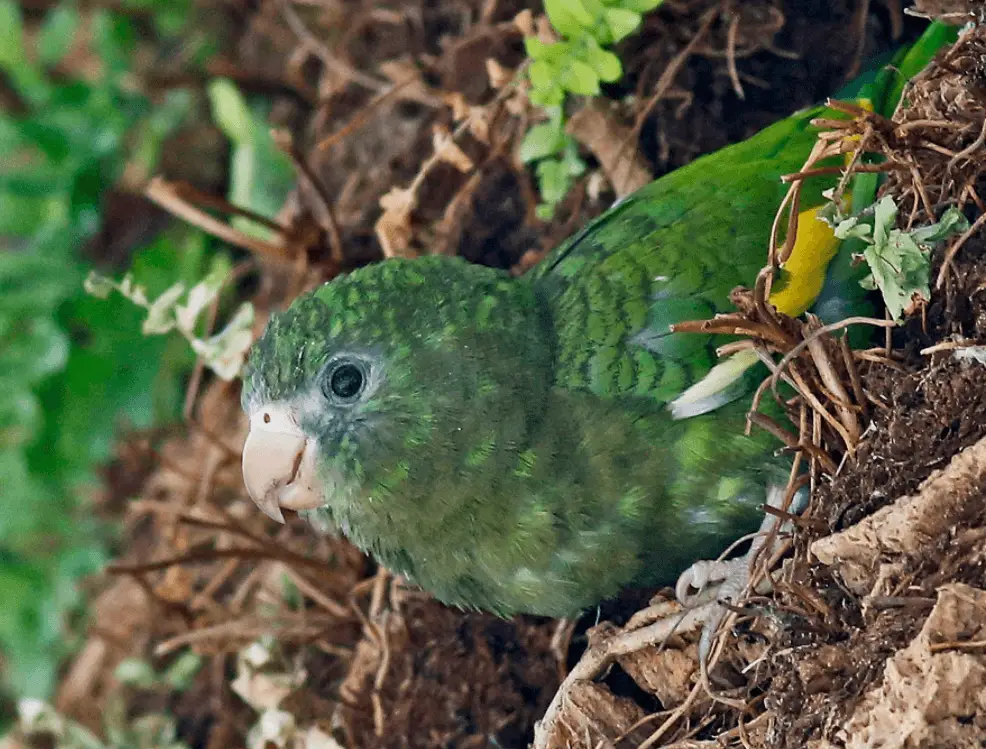
Molt and plumage terminology follow, White-winged Parakeet, along with all psittacids as far as known, exhibits a Complex Basic Strategy, including incomplete-to-complete prebasic molts and a partial preformative molt but no alternate molts.
Prejuvenile (First Pre basic) Molt
Complete, primarily May–July in Florida populations, in and near the nest. Little information on the timing or sequence of pennaceous feather irruption and development.
Based on captured nestlings from the Miami population, at about 10–12 d of age wing chords measured 29.0 mm (about 20% of the adult size) and 19.0 mm (15% of the adult size); later in captivity, 5 chicks averaged 2.0 mm of outer primary growth per day when < 18 d old and 1.6 mm of growth when > 18 d old.
Growth of rectrices is slower than that of wing; birds one-third through the nestling stage showed only about 3% of adult tail length.
Summarizing development for the genus Brotogeris as a whole, Harris reported that by day 12 feathers are visible under the skin and on the back and sides, and by day 26 feathers begin to erupt, first on tail and wings, then on the rest of the body.
Duration of Prejuvenile Molt among individual White-winged Parakeets probably around 25–30 d, presumably near-completed by fledging at 30–35 d.
Preformative Molt
“First Pre basic” or “Pre basic I” Molt of Humphrey and Parkes and some later authors; see revision by Howell et al. Partial; timing unknown but likely 1–5 mo following fledging orca.
Aug–Dec in Florida populations, occurring on or near the breeding grounds. This molt has not been studied in White-winged Parakeet but in other Psittacids,
White winged parakeet includes most or all body feathers but few any upper wing secondary coverts and no primary coverts, primaries, secondaries, or rectrices.
Definitive Pre basic Molt
Complete (or probably sometimes incomplete), on or near breeding grounds. As in most other Psittacids, molt could commence during incubation, suspend for chick feeding, and resume the following breeding, or during Mar–Nov in Florida populations; five of 31 birds trapped in Miami in Mar showed molt of head feathers, and adults captured in May, Jun, and Sep showed molt of both flight and body feathers.
Non-breeding parakeets (including many undergoing the Second Pre basic Molt) likely do not suspend molt and average earlier timing than breeding birds; one captive bird began the Second Pre basic Molt at 11–12 mo of age.
Primaries are replaced bilaterally from p5 (probably also p6) and secondaries are replaced bilaterally from s5 and distally from the tertials. Rectrices may be replaced in order r1-r5-r6-r2-r3-r4, as documented for Monk Parakeet although other sequences are likely.
Suspension of molt during breeding and incomplete molts, recorded in other Psittacids, could occur occasionally in White winged parakeets; the innermost primary and secondaries among s6-s7 and s1-s2 might be the feathers most expected to be retained during incomplete molts.

